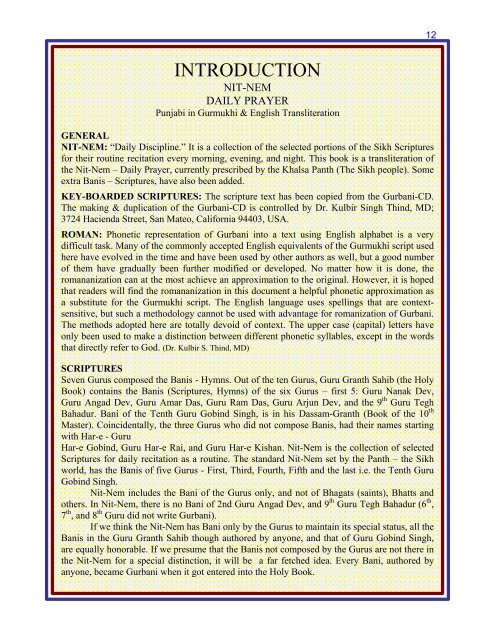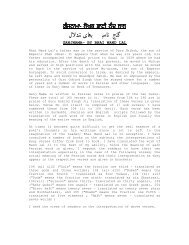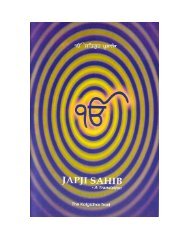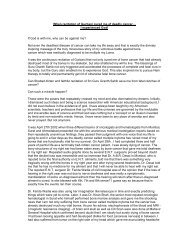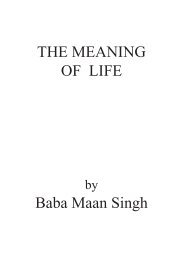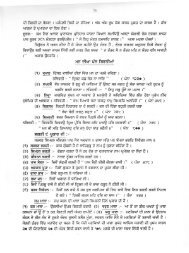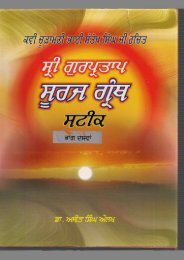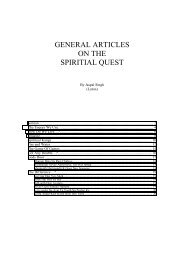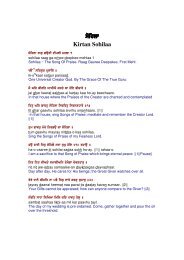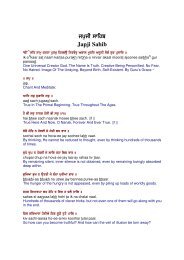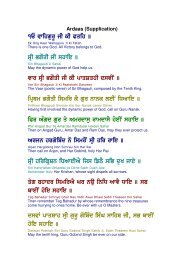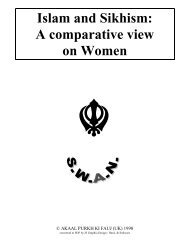- Page 4 and 5: 4THANKSMy sincere thanks are due to
- Page 6 and 7: 6DAILY PRAYERThe Sikh Scripture is
- Page 8 and 9: Chester, Virginia 23836, USA.8
- Page 10 and 11: FOREWORDThe current Nit-Nem (the Sc
- Page 14 and 15: 14his death, Guru Gobind Singh decl
- Page 16 and 17: 16The present situation is very uns
- Page 18 and 19: 18“Tav Parsaad Svayae, Paatshahee
- Page 21 and 22: CONTENTSDedication ----------------
- Page 23 and 24: 23Awid scu jugwid scu ]aad sach jug
- Page 25 and 26: 25Some obtain His Blessings (libera
- Page 27 and 28: 27kiQ kiQ kQI kotI koit koit ]kath
- Page 29 and 30: 29QwipAw n jwie kIqw n hoie ]thaapi
- Page 31 and 32: 31qIriQ nwvw jy iqsu Bwvw ivxu Bwxy
- Page 33 and 34: 33suixAY isD pIr suir nwQ ]suni-ai
- Page 35 and 36: 35realizing Him) and the secrets of
- Page 37 and 38: 37suixAY syK pIr pwiqswh ]suni-ai s
- Page 39 and 40: 39Virtues of His Name). ||12||mMnY
- Page 41 and 42: 41jy ko mMin jwxY min koie ]14]jay
- Page 43 and 44: 43krqy kY krxY nwhI sumwru ]kartay
- Page 45 and 46: 45lyKw iliKAw kyqw hoie ]laykhaa li
- Page 47 and 48: 47hn)[Countless recite the Scriptur
- Page 49 and 50: 49Numberless are persons who do not
- Page 51 and 52: 51AKrI ilKxu bolxu bwix ]akhree lik
- Page 53 and 54: 53BrIAY miq pwpw kY sMig ]bharee-ai
- Page 55 and 56: 55siq suhwxu sdw min cwau ]sat suha
- Page 57 and 58: 57approved, or accepted, in His Cou
- Page 59 and 60: 59skdw[We cannot know about God eve
- Page 61 and 62: 61vfw dwqw iqlu n qmwie ]vadaa daat
- Page 63 and 64:
63ijs no bKsy isPiq swlwh ]jis no b
- Page 65 and 66:
65AwKih pVy krih viKAwx ]aakhahi pa
- Page 67 and 68:
67so dru kyhw so Gru kyhw ijqu bih
- Page 69 and 70:
69gwvin rqn aupwey qyry ATsiT qIrQ
- Page 71 and 72:
71muMdw sMqoKu srmu pqu JolI iDAwn
- Page 73 and 74:
73Awid AnIlu Anwid Anwhiq jugu jugu
- Page 75 and 76:
75Awdysu iqsY Awdysu ]aadays tisai
- Page 77 and 78:
77Awpxy igAwn dy bl qy fUMGI surq i
- Page 79 and 80:
79(And for their permission to ente
- Page 81 and 82:
81kyqIAw KwxI kyqIAw bwxI kyqy pwq
- Page 83 and 84:
83nyk kmweI: Awmdn, inSkwm-syvw, ny
- Page 85 and 86:
85kir kir vyKY ndir inhwl ]kar kar
- Page 87 and 88:
87Let the love (of God) be the Cruc
- Page 89 and 90:
89jwpu swihbJAAPU SAHIB siqgur pRsw
- Page 91 and 92:
91nmsqM ArUpy ] nmsqM AnUpy ]2]Nama
- Page 93 and 94:
93Creation is You).nmsqM ABUqy ] nm
- Page 95 and 96:
95(Worldly attributes - the world h
- Page 97 and 98:
97nmsqsqu dyvY ] nmsqM AByvY ]Namas
- Page 99 and 100:
99nmo jog jogy ] nmo Bog Bogy ]Namo
- Page 101 and 102:
101ABUq hYN ] ABrn hYN ]34]Abhoot.
- Page 103 and 104:
103Akrm hYN ] ABrm hYN ]41]Akarm ha
- Page 105 and 106:
105nmo gIq gIqy ] nmo qwn qwny ]47]
- Page 107 and 108:
107nmo in`q nwrwiexy k®¨r krmy ]N
- Page 109 and 110:
109prM prm prmysÍrM pRoC pwlµ ]Pa
- Page 111 and 112:
111nmsqÍM Akwly ] nmsqÍM Apwly ]N
- Page 113 and 114:
113nmo jIv jIvM ] nmo bIj bIjy ]Nam
- Page 115 and 116:
115srbM kwly ] srbM pwly ]78]Sarban
- Page 117 and 118:
117ivc byAMq srUpW (SklW) ivc zwihr
- Page 119 and 120:
119He is the source of Dharma (Disc
- Page 121 and 122:
121gun gn audwr ] mihmw Apwr ]Gunn
- Page 123 and 124:
123AwilsÎ krm ] AwidRsÎ Drm ]Aali
- Page 125 and 126:
125n s`qRY ] n im`qRY ] n BrmM ] n
- Page 127 and 128:
127You are the Creator of the unive
- Page 129 and 130:
129ik srb`qR jwho ] ik srb`qR Bwho
- Page 131 and 132:
131You are the most intelligent, an
- Page 133 and 134:
133smsqul slwm hYN ] sdYvl Akwm hYN
- Page 135 and 136:
135Anaukiq srUp hYN ] pRjugiq AnUp
- Page 137 and 138:
137AlyK hYN ] AByK hYN ]Alaekh haae
- Page 139 and 140:
139(Knowledge).AnµgM srUpy ] ABMgM
- Page 141 and 142:
141ik kwml krIm hYN ] ik rwzk rhIm
- Page 143 and 144:
143You are a Wonderful Compassion (
- Page 145 and 146:
145Your Glory is Great. Your State
- Page 147 and 148:
147AxbRx- Anvrx: qyry qy koeI vwr n
- Page 149 and 150:
149Aik®qw ik®q hYN ] AimRqw imRq
- Page 151 and 152:
151Awqm bs hYN ] js ky js hYN ]184]
- Page 153 and 154:
153nmo klh krqw nmo sWq rUpy ]Namo
- Page 155 and 156:
155AnwQy ] pRmwQy ] AjonI ] AmonI ]
- Page 157 and 158:
157suXMBv suBM srbdw srb jugqy ]Suy
- Page 159 and 160:
159mwqy mqMg jry jr sMg AnUp auqMg
- Page 161 and 162:
161sRI Bgvwn Bjy ibnu BUpiq eyk rqI
- Page 163 and 164:
163puMn pRqwpn bwF jYq Dun pwpn ky
- Page 165 and 166:
165kwhU liKE hir AvwcI idsw mih kwh
- Page 167 and 168:
167au~qy KVw qyrI v`ifAweI krdw hY[
- Page 169 and 170:
169hoir kyqy quDno gwvin sy mY iciq
- Page 171 and 172:
171All the worshippers worshipped Y
- Page 173 and 174:
173AwKix AauKw swcw nwau ]aakhan a-
- Page 175 and 176:
175Ksmu ivswrih qy kmjwiq ]khasam v
- Page 177 and 178:
177rwgu gUjrI mhlw 5 ]raag goojree
- Page 179 and 180:
179 siqgur pRswid ]ik-o N kaar satg
- Page 181 and 182:
181Those who think of the Fearless
- Page 183 and 184:
183jnu nwnku gux gwvY krqy ky jI jo
- Page 185 and 186:
185Those persons with Your knowledg
- Page 187 and 188:
187Awsw mhlw 5 ]aasaa mehlaa 5.Awsw
- Page 189 and 190:
189Apnw jwn kro pRiqpwrw ]1]Apnaa j
- Page 191 and 192:
191mrn kwl kw qRws invirXY ]Maran k
- Page 193 and 194:
193jvn kwl sB jgq bnwXo ]Javan kaal
- Page 195 and 196:
195Gt Gt ky pt pt kI jwnYN ]12]Ghat
- Page 197 and 198:
197These unwise people do not know
- Page 199 and 200:
199(Ages), and Who is Self-Created.
- Page 201 and 202:
201duSt Cwh CÍY skY n koeI ]23]D.u
- Page 203 and 204:
203dohrw ]D.ohraaieh dohrw hY - kiv
- Page 205 and 206:
205khY nwnku mMn myry sdw rhu hir n
- Page 207 and 208:
207In that blessed house the Panch-
- Page 209 and 210:
209Qwl ivic iqMin vsqU peIE squ sMq
- Page 211 and 212:
211soihlwis&q-swlwh, vwihgurU dy gu
- Page 213 and 214:
213sdxhwrw ismrIAY nwnk sy idh AwvM
- Page 215 and 216:
215kYsI AwrqI hoie ] Bv KMfnw qyrI
- Page 217 and 218:
217these two into pieces (Removed t
- Page 219 and 220:
219AauD GtY idnsu rYxwry ] mn gur i
- Page 221 and 222:
221Sbd hjwrymwJ mhlw 5 caupdy Gru 1
- Page 223 and 224:
223huix kid imlIAY ipRA quDu BgvMqw
- Page 225 and 226:
225dUK ivswrxu syivAw sdw sdw dwqwr
- Page 227 and 228:
227prmwqmw qy Brosw krdw, nwm jpdw
- Page 229 and 230:
229giver of His Name, then He gives
- Page 231 and 232:
231vwihgurU, dy nwl ipAwr rKdI hovy
- Page 233 and 234:
233these things we achieve Husband
- Page 235 and 236:
235Mind is the scale, awareness wei
- Page 237 and 238:
237own. ||1||qyry gux gwvw dyih buJ
- Page 239 and 240:
239nhI lvWgw[(nwm jwp dy kwrx mu`kq
- Page 241 and 242:
241Anµdu swihbANAND SAHIB“AnMd
- Page 243 and 244:
243enchanting Raags and Raaganees:
- Page 245 and 246:
245kr, dy skdw hYN)!Nanak says, O m
- Page 247 and 248:
247krn nUM l`gdy hn[Only those whom
- Page 249 and 250:
249Surma: eye-powder, of knowledge,
- Page 251 and 252:
251hukmu mMinhu gurU kyrw gwvhu scI
- Page 253 and 254:
253ey mn ipAwirAw qU sdw scu smwly
- Page 255 and 256:
255khY nwnku qU sdw AgMmu hY qyrw A
- Page 257 and 258:
257inmrqw PV leI hY, gurU dI Srn lY
- Page 259 and 260:
259ieik iPrih Gnyry krih glw glI ik
- Page 261 and 262:
261mMnu Dovhu sbid lwghu hir isau r
- Page 263 and 264:
263Name of God appeases: destroys,
- Page 265 and 266:
265Anyk jUnI Brim AwvY ivxu siqgur
- Page 267 and 268:
267dI krxI-S`kqI, Awqimkqw nhI[ ieh
- Page 269 and 270:
269hY, Aqy ieh igAwn qW huMdw hY jy
- Page 271 and 272:
271iqhI guxI sMswru BRim suqw suiqA
- Page 273 and 274:
273people already in the world.mwie
- Page 275 and 276:
275ijs dw jIau iqsu imil rhY hir vs
- Page 277 and 278:
277Name, you shall not be thirsty a
- Page 279 and 280:
279hir gwau mMglu inq sKIey sogu dU
- Page 281 and 282:
281other than Him (In everything yo
- Page 283 and 284:
283khY nwnku AMimRq nwmu suxhu pivq
- Page 285 and 286:
285Kindness. ||38||(The body that d
- Page 287 and 288:
287sMq swjn Bey srsy pUry gur qy jw
- Page 289 and 290:
289Anµdu swihb (Cotw)ANAND SAHIB (
- Page 291 and 292:
291True Master, what is not in Your
- Page 293 and 294:
293Duir krim pwieAw quDu ijn kau is
- Page 295 and 296:
295cOpeI ]kvI dI aucwrI, bynqI, cOp
- Page 297 and 298:
297I may not leave You and worship
- Page 299 and 300:
299This all is the play of the Will
- Page 301 and 302:
301sB pr ik®pw idRsit kr PUlw ]11]
- Page 303 and 304:
303beginning, and without being bor
- Page 305 and 306:
305khUM PUl rwjw hÍY bYTw ]Kahoon:
- Page 307 and 308:
307They always get Your protection.
- Page 309 and 310:
309cOpeIhr bMd dIAW cwr lweInw hnCH
- Page 311 and 312:
311AlK rUp A`CY AnByKw]Alakh Roop a
- Page 313 and 314:
313niyq nyiq muK cwr bqwieE]5]Naet.
- Page 315 and 316:
315sBhUM srb TOir pihcwnw]8]Sabh-ho
- Page 317 and 318:
317ArdwsARD.AASbynqIInvocationvwihg
- Page 319 and 320:
319God, shared food, ran free kitch
- Page 321 and 322:
321]Hae Nimaan.eaan’ d.ae Maan.,


